Related Research Articles

Nicosia is the largest city, capital, and seat of government of Cyprus. It is located near the centre of the Mesaoria plain, on the banks of the River Pedieos.

Old Town Hall is a complex of buildings from the 14th century in the Old Town of Bratislava, the capital of Slovakia. It is the oldest city hall in the country and it is one of the oldest stone buildings still standing in Bratislava, with the tower being built approximately in 1370. The town hall was created in the 15th century by connecting three townhouses, and then went through several reconstructions in the course of the centuries.

The Palazzo Spada is a palace located on Piazza di Capo Ferro #13 in the rione Regola of Rome, Italy. Standing very close to the Palazzo Farnese, it has a garden facing towards the Tiber river.

Nicosia is a Town and comune of the province of Enna in Sicily, southern Italy. It is located at 720 m above the sea level, on a rocky massive culminating in four imposing hills. The origin of Nicosia is uncertain. Nicosia and Troina are the northernmost towns in the province of Enna. The vicinity was traditionally made up of salt mines and arable lands.
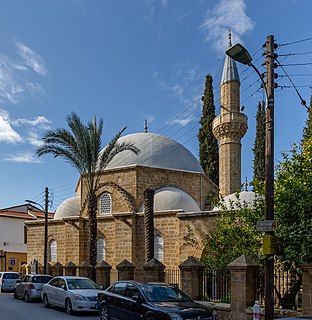
Arab Ahmet Mosque is situated in the western Arab Ahmet Quarter of North Nicosia, Cyprus. It was built in the late 16th century. The Mosque is named after a commander of the 1571 Ottoman army. The mosque is the tombs of some important persons of the past in its garden.
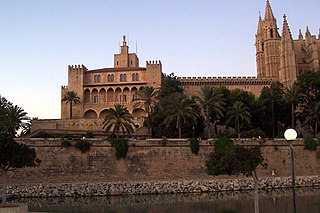
The Royal Palace of La Almudaina is the Alcázar of Palma, the capital city of the Island of Majorca, Spain.

Husulu, historically also Kashataghk is a village in the Lachin District of Azerbaijan, close to the villages of Ağoğlan and Qarıqışlaq.
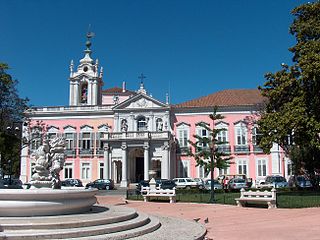
The Necessidades Palace is a historic building in the Largo do Rilvas, a public square in Lisbon, Portugal. It serves as headquarters of the Portuguese Foreign Ministry. The Palace has been classified as a Property of Public Interest since 1983.
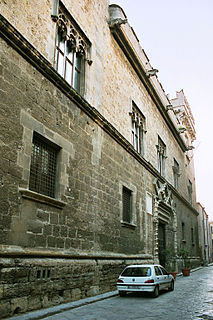
Palazzo Abatellis is a palazzo in Palermo, Sicily, southern Italy, located in the Kalsa quarter. It is home to the Galleria Regionale della Sicilia, the Gallery of Art for the Sicilian region.

Notre Dame de Tyre or Our Lady of Tyre, or simply as Armenian church is a monastic church in Nicosia, Cyprus. It is located in the Arab Ahmet quarter, in Salahi Şevket Street, formerly known as Victoria Street.

Palazzo Aragona Gonzaga is a 16th-century palace in Rome, Italy; it was once the residence of Cardinal Scipione Gonzaga. Today, its late Renaissance street facade bears plaques commemorating two of its residents, Saint Aloysius Gonzaga and the poet Torquato Tasso.

The Cyprus Folk Art Museum is a museum in Cyprus dedicated to the country's ethnographic history. The museum is located in Nicosia directly beside the Cathedral of Agios Ioannis Evangelistis, the Byzantine Museum of Cyprus, the National Struggle Museum, and the current Archbhishop's Palace. The square beside the cathedral and museum is named after Kyprianos of Cyprus who was executed by the Ottomans in 1821 for his support of the Greek Revolution. Facing the museum and cathedral is the Pancyprian Gymnasium, founded in 1812 by Kyprianos and the oldest educational institution in Cyprus. During the 1990s the name of the museum was changed to the Ethnographic Museum for a short period. The museum is a non-profit cultural organisation and has depended on volunteers since it was founded in 1937.

The Revoltella Museum is a modern art gallery founded in Trieste in 1872 by Baron Pasquale Revoltella. The baron, after he left his house to the city and all the works, furniture and books it contained.

Sarayönü, officially Atatürk Square, is a square in North Nicosia. It is the centre of the Turkish part of the city and was the administrative center of the island for centuries.
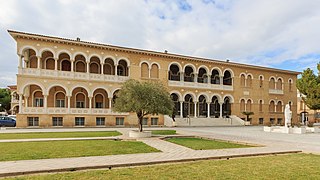
Archbishop's Palace is the official residence and office of the archbishop of Cyprus located in Nicosia. The palace was built next to the "Old Archbishop's Palace", between 1956 and 1960; in neo-Byzantine architectural style. Its general plans were designed by George Nomikos in Athens, while Nicholas S. Roussos and John Pericleous from Limassol were responsible for all other architectural work. The bronze sculpture of Makarios III, the first president of Cyprus, was on its grounds but has now been moved the monastery of Kykkos. It was sculpted by Nikolas Kotziamannis, weighs around 13 tons and is approximately 30 feet tall. Although the Archbishop's Palace is not open to the public; the Byzantine Museum, Library of the Archbishopric, Folk Art Museum and the National Struggle Museum located on its grounds are open to the public.
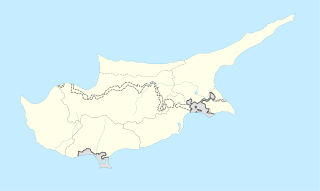
Haydar Pasha is a Neighbourhood, Quarter or Mahalle of Nicosia, Cyprus and the mosque situated therein. Both are named after Haydar Pasha, said to be one of the 12 generals in command of divisions of the Ottoman army at the time of the Ottoman conquest of Nicosia. Each general being posted to a quarter, that quarter was known by his name.

Kumarcilar Han is a caravansarai located in North Nicosia, Northern Cyprus. It is unknown when exactly it was built, however it is thought to be built around the end of the 17th century, is much smaller and modest when compared with Büyük Han. Similar to all caravansarai, the entrance leads to an open-air courtyard, which is surrounded by a two-storey building, originally containing 56 rooms. Those on the upper story were used by the travelers, while those on the ground floor were used for their animals and belongings. Since then, the Kumarcilar Han has entered into a state of disrepair, is in danger of collapse. Efforts to restore the building have been hampered, due to lack of funds.

Dervish Pasha Mansion is a historical mansion and ethnographic museum in the Arab Ahmet quarter of Nicosia, currently located in North Nicosia. It lies on the Beliğ Paşa Street and has two floors. It is considered to be one of the finest examples of Ottoman architecture in Cyprus.
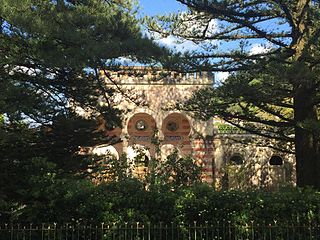
Quinta do Relógio is a quinta located near the historic center of Sintra, on the Portuguese Riviera. It is classified as a World Heritage Site by UNESCO within the "Cultural Landscape of Sintra". Along with the nearby palaces such as Seteais Palace and the Quinta da Regaleira next to it, it is considered one of the tourist attractions of Sintra. The property consists of a romantic palace and chapel, and a park. Relógio was featured in numerous publications internationally including Variety magazine, and Architectural Digest, when pop star Madonna reportedly purchased the property.

Melik Haykaz Palace is a 15th-century palace in the village of Hüsülü in the Lachin District of Azerbaijan. It is believed to have been built by Melik Haykaz I (1450-1520), the first ruler of the Armenian Agachech-Kashatagh melikdom. The palace was built on a slope surrounded by a fortified wall with towers and gates. It had several floors, with Melik Haykaz's living room being located on the ground floor and his throne room being located on the second floor. Architect Artak Ghulyan describes it as a link between the architectural style of 12-14th century palaces of Khachen and Vayots Dzor provinces and the 17-18th century palaces of the meliks of Nagorno-Karabakh and Zangezur. The palace underwent renovation from 1989 to 1992. It was turned into a hotel in 2007, while the Lachin District was under the occupation of the self-proclaimed Republic of Artsakh.
References
- ↑ EcoMuseo Nicosia, entry on palace.